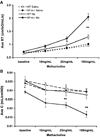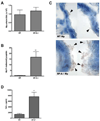SP-A preserves airway homeostasis during Mycoplasma pneumoniae infection in mice
- PMID: 19494306
- PMCID: PMC3656438
- DOI: 10.4049/jimmunol.0900452
SP-A preserves airway homeostasis during Mycoplasma pneumoniae infection in mice
Erratum in
-
Correction: SP-A Preserves Airway Homeostasis during Mycoplasma pneumoniae Infection in Mice.J Immunol. 2015 Sep 15;195(6):2917-8. doi: 10.4049/jimmunol.1501597. J Immunol. 2015. PMID: 26342104 No abstract available.
Abstract
The lung is constantly challenged during normal breathing by a myriad of environmental irritants and infectious insults. Pulmonary host defense mechanisms maintain homeostasis between inhibition/clearance of pathogens and regulation of inflammatory responses that could injure the airway epithelium. One component of this defense mechanism, surfactant protein-A (SP-A), exerts multifunctional roles in mediating host responses to inflammatory and infectious agents. SP-A has a bacteriostatic effect on Mycoplasma pneumoniae (Mp), which occurs by binding surface disaturated phosphatidylglycerols. SP-A can also bind the Mp membrane protein, MPN372. In this study, we investigated the role of SP-A during acute phase pulmonary infection with Mp using mice deficient in SP-A. Biologic responses, inflammation, and cellular infiltration, were much greater in Mp infected SP-A(-/-) mice than wild-type mice. Likewise, physiologic responses (airway hyperresponsiveness and lung compliance) to Mp infection were more severely affected in SP-A(-/-) mice. Both Mp-induced biologic and physiologic changes were attenuated by pharmacologic inhibition of TNF-alpha. Our findings demonstrate that SP-A is vital to preserving lung homeostasis and host defense to this clinically relevant strain of Mp by curtailing inflammatory cell recruitment and limiting an overzealous TNF-alpha response.
Figures






Comment in
-
Findings of Research Misconduct.Fed Regist. 2019 Nov 7;84(216):60097-60098. Fed Regist. 2019. PMID: 37547121 Free PMC article. No abstract available.
Similar articles
-
Surfactant protein-A suppresses eosinophil-mediated killing of Mycoplasma pneumoniae in allergic lungs.PLoS One. 2012;7(2):e32436. doi: 10.1371/journal.pone.0032436. Epub 2012 Feb 23. PLoS One. 2012. PMID: 22384248 Free PMC article.
-
Review: Collectins link innate and adaptive immunity in allergic airway disease.Innate Immun. 2010 Jun;16(3):183-90. doi: 10.1177/1753425910368446. Epub 2010 Apr 23. Innate Immun. 2010. PMID: 20418258 Free PMC article. Review.
-
The Immune Modulatory Role of Surfactants in Mycoplasma pneumoniae Infection.J Inflamm Res. 2025 Feb 26;18:2909-2922. doi: 10.2147/JIR.S507526. eCollection 2025. J Inflamm Res. 2025. PMID: 40034686 Free PMC article. Review.
-
Mast cell TNF receptors regulate responses to Mycoplasma pneumoniae in surfactant protein A (SP-A)-/- mice.J Allergy Clin Immunol. 2012 Jul;130(1):205-14.e2. doi: 10.1016/j.jaci.2012.03.002. Epub 2012 Apr 12. J Allergy Clin Immunol. 2012. PMID: 22502799 Free PMC article.
-
A 20-Mer Peptide Derived from the Lectin Domain of SP-A2 Decreases Tumor Necrosis Factor Alpha Production during Mycoplasma pneumoniae Infection.Infect Immun. 2020 Aug 19;88(9):e00099-20. doi: 10.1128/IAI.00099-20. Print 2020 Aug 19. Infect Immun. 2020. PMID: 32513852 Free PMC article.
Cited by
-
Pulmonary surfactant: an immunological perspective.Cell Physiol Biochem. 2010;25(1):13-26. doi: 10.1159/000272047. Epub 2009 Dec 22. Cell Physiol Biochem. 2010. PMID: 20054141 Free PMC article. Review.
-
Surfactant protein-A suppresses eosinophil-mediated killing of Mycoplasma pneumoniae in allergic lungs.PLoS One. 2012;7(2):e32436. doi: 10.1371/journal.pone.0032436. Epub 2012 Feb 23. PLoS One. 2012. PMID: 22384248 Free PMC article.
-
Review: Collectins link innate and adaptive immunity in allergic airway disease.Innate Immun. 2010 Jun;16(3):183-90. doi: 10.1177/1753425910368446. Epub 2010 Apr 23. Innate Immun. 2010. PMID: 20418258 Free PMC article. Review.
-
An Allergic Lung Microenvironment Suppresses Carbon Nanotube-Induced Inflammasome Activation via STAT6-Dependent Inhibition of Caspase-1.PLoS One. 2015 Jun 19;10(6):e0128888. doi: 10.1371/journal.pone.0128888. eCollection 2015. PLoS One. 2015. PMID: 26091108 Free PMC article.
-
The Immune Modulatory Role of Surfactants in Mycoplasma pneumoniae Infection.J Inflamm Res. 2025 Feb 26;18:2909-2922. doi: 10.2147/JIR.S507526. eCollection 2025. J Inflamm Res. 2025. PMID: 40034686 Free PMC article. Review.
References
-
- Clements JA. Surface tension of lung extracts. Proc Soc Exp Biol Med. 1957;95:170–172. - PubMed
-
- Pattle RE. Properties, function and origin of the alveolar lining layer. Nature. 1955;175:1125–1126. - PubMed
-
- Borron P, McCormack FX, Elhalwagi BM, Chroneos ZC, Lewis JF, Zhu S, Wright JR, Shepherd VL, Possmayer F, Inchley K, Fraher LJ. Surfactant protein A inhibits T cell proliferation via its collagen-like tail and a 210-kDa receptor. Am J Physiol. 1998;275:L679–L686. - PubMed
-
- Brinker KG, Garner H, Wright JR. Surfactant protein A modulates the differentiation of murine bone marrow-derived dendritic cells. Am J Physiol Lung Cell Mol Physiol. 2003;284:L232–L241. - PubMed
-
- Stamme C, Walsh E, Wright JR. Surfactant protein A differentially regulates IFN-gamma- and LPS-induced nitrite production by rat alveolar macrophages. Am J Respir Cell Mol Biol. 2000;23:772–779. - PubMed
Publication types
MeSH terms
Substances
Grants and funding
LinkOut - more resources
Full Text Sources
Molecular Biology Databases

